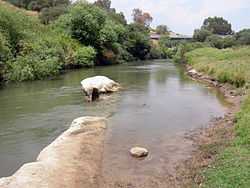Bnot Ya'akov Bridge

Bnot Ya'akov Bridge (Hebrew: גשר בנות יעקב, Gesher Bnot Ya'akov; Arabic: جسر بنات يعقوب, Jisr Banât Ya'qūb, lit. Crossing of Jacob's Daughters)[1] is a bridge across the Jordan River on Highway 91, straddling the border between Israel and the Israeli-occupied portion of the Golan Heights. The area around the bridge was settled in antiquity, and a river crossing there, known as Jacob's Ford, served as part of the regional route between central Israel and Syria, along the ancient Via Maris.
Archaeological remains at the site analyzed by archaeologists from the Hebrew University of Jerusalem, Germany and the United States, found that Lower Paleolithic ancestors living on the lake shore produced stone tools, butchered animals, gathered plant food and controlled fire as early as 790,000 years ago. [2]
The bridge is of strategic military and historical significance as it is one of the few fixed crossing points over the northern Jordan River which enable access from the Golan Heights to the Upper Galilee.
History

Jacob's Ford was a key river crossing point and major trade route between Acre and Damascus.[3] Jacob's Ford was also one of the safest crossings of the river Jordan and was utilized by Christian Palestine and Seljuk Syria as a major intersection between the two civilizations, making it strategically important. When Humphrey II of Toron was besieged in the city of Baniyas in 1157, King Baldwin III of Jerusalem was able to break the siege, only to be ambushed at Jacob's Ford in June of that year.[4] Later in the twelfth century, Baldwin IV of Jerusalem and Saladin continually contested the area around Jacob's Ford. Baldwin built a castle close to Jacob's Ford commanding the road from Quneitra to Tiberias.[5]
On 23 August 1179 the Battle of Jacob's Ford took place there.
Modern era
The bridge was destroyed in 1918 during the Sinai and Palestine Campaign of World War I by Turkish forces retreating from a British attack, but was rebuilt. On the "night of the bridges" between 16 and 17 June 1946, the bridge was again destroyed by the Haganah. The Syrians captured the bridge on June 11, 1948, during the 1948 Palestine war, but later withdrew as a result of the 1949 Armistice Agreements between Israel and Syria. After the war, the bridge was in the central demilitarised zone established by the armistice agreement.
In 1953, the site was chosen as the original location for the water intake of Israel's National Water Carrier project, but after US pressure the intake was moved downstream to the Sea of Galilee at Eshed Kinrot.<ref name=JSCR">Sosland, Jeffrey (2007) Cooperating Rivals: The Riparian Politics of the Jordan River Basin SUNY Press, ISBN 0-7914-7201-9 p 70</ref>
During the Six Day War, an Israeli paratrooper brigade captured the area and the Israeli Combat Engineering Corps constructed a Bailey bridge.
In the Yom Kippur War, Syrian forces approached the vicinity of the bridge but did not cross it.
By 2007 there were two Bailey bridges employed at the site, one for traffic from east to west and the other for the opposite direction. However, in 2007 a modern concrete span was completed and as a consequence one of the Bailey bridges was dismantled and the other left intact for use on an emergency basis.
Archaeological site
Archaeological excavations at the prehistoric Gesher Bnot Ya'akov site, have revealed evidence of human habitation in the area, from as early as 750,000 years ago.[6] Archeologists from the Hebrew University of Jerusalem claim that the site provides evidence of "advanced human behavior" half a million years earlier than has previously been estimated. Their report describes an Acheulian (early stone age culture) layer at the site where numerous stone tools, animal bones and plant remains have been found.[7]
References
- ↑ Sharon, Moshe (1997) Corpus Inscriptionum Arabicarum Palaestinae, (CIAP) BRILL, ISBN 90-04-11083-6, p. 41
- ↑ Dig site shows distinct living spaces in early Stone Age
- ↑ Alan V. Murray, ed. (2006), The Crusades: An Encyclopaedia, ISBN 1-57607-862-0 p 649.
- ↑ Richard, Jean (1999) The Crusades c.1071-c.1291 Cambridge University press ISBN 0-521-62566-1 pp 175-176
- ↑ Payne, Robert (1998) The Crusades: A History Wordsworth Editions, ISBN 1-85326-689-2 p 188
- ↑ Evidence found of early modern humans (January 5, 2010) in Israel 21c Innovation News Service Retrieved 2010-01-05
- ↑ Evidence of advanced human life half a million years earlier than previously thought (Dec 22, 2009) in The Jerusalem Post Retrieved 2010-01-05
Bibliography
- Murray, Alan V. editor. (2006), The Crusades: An Encyclopaedia, ISBN 1-57607-862-0
- Payne, Robert (1998) The Crusades: A History Wordsworth Editions, ISBN 1-85326-689-2
- Richard, Jean (1999) The Crusades c.1071-c.1291 Cambridge University press ISBN 0-521-62566-1
- Sharon, Moshe (1997) Corpus Inscriptionum Arabicarum Palaestinae, (CIAP) BRILL, ISBN 90-04-11083-6
External links
| Wikimedia Commons has media related to Bnot Ya'akov Bridge. |
- Bridge at Jisr Banat Ya'qub, 12th-century bridge pictured early 20th century.
- 80th Brigade's Battles in the Six-Day War. Paratroopers Brigade website. (Hebrew)
- Bridge Destruction During the Night of the Bridges (Hebrew)
- Gesher Benot Ya'aqov - an Introduction.
Coordinates: 33°0′37.02″N 35°37′41.83″E / 33.0102833°N 35.6282861°E